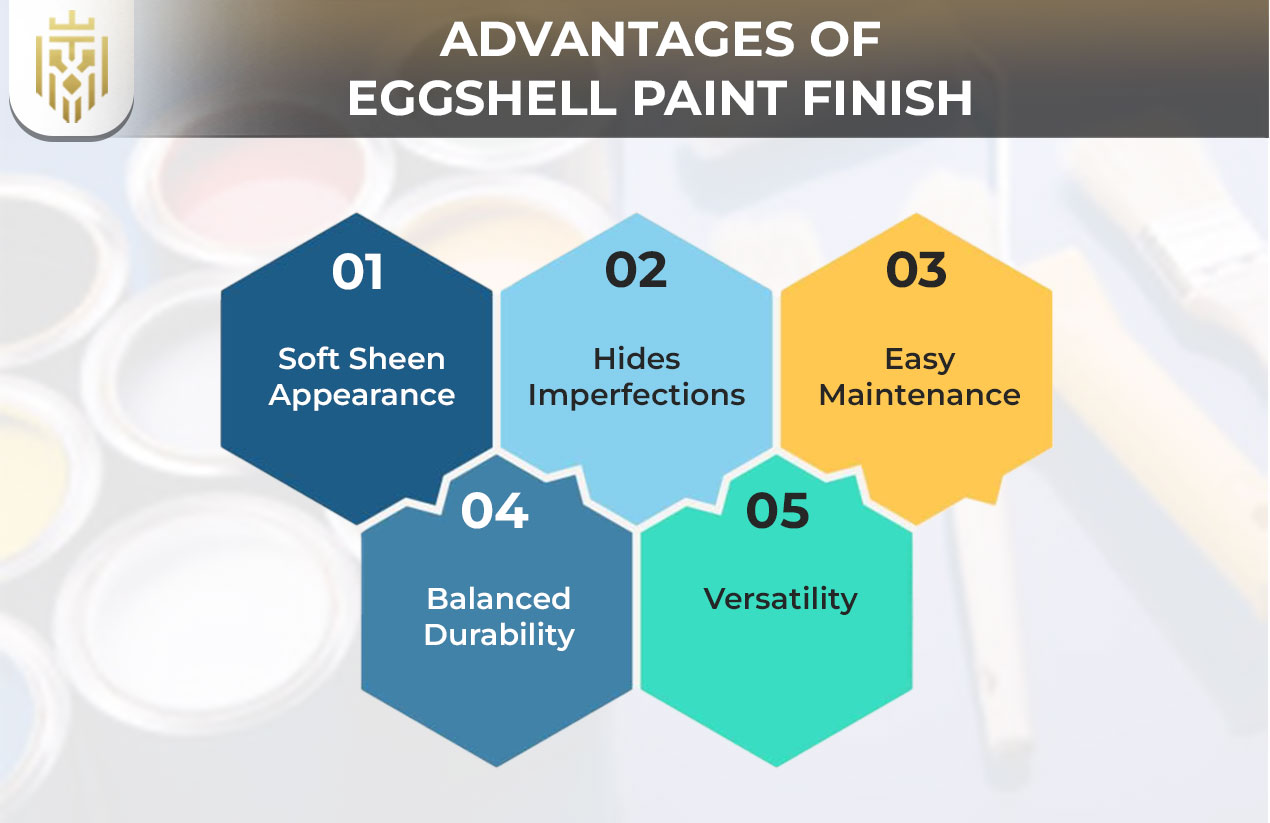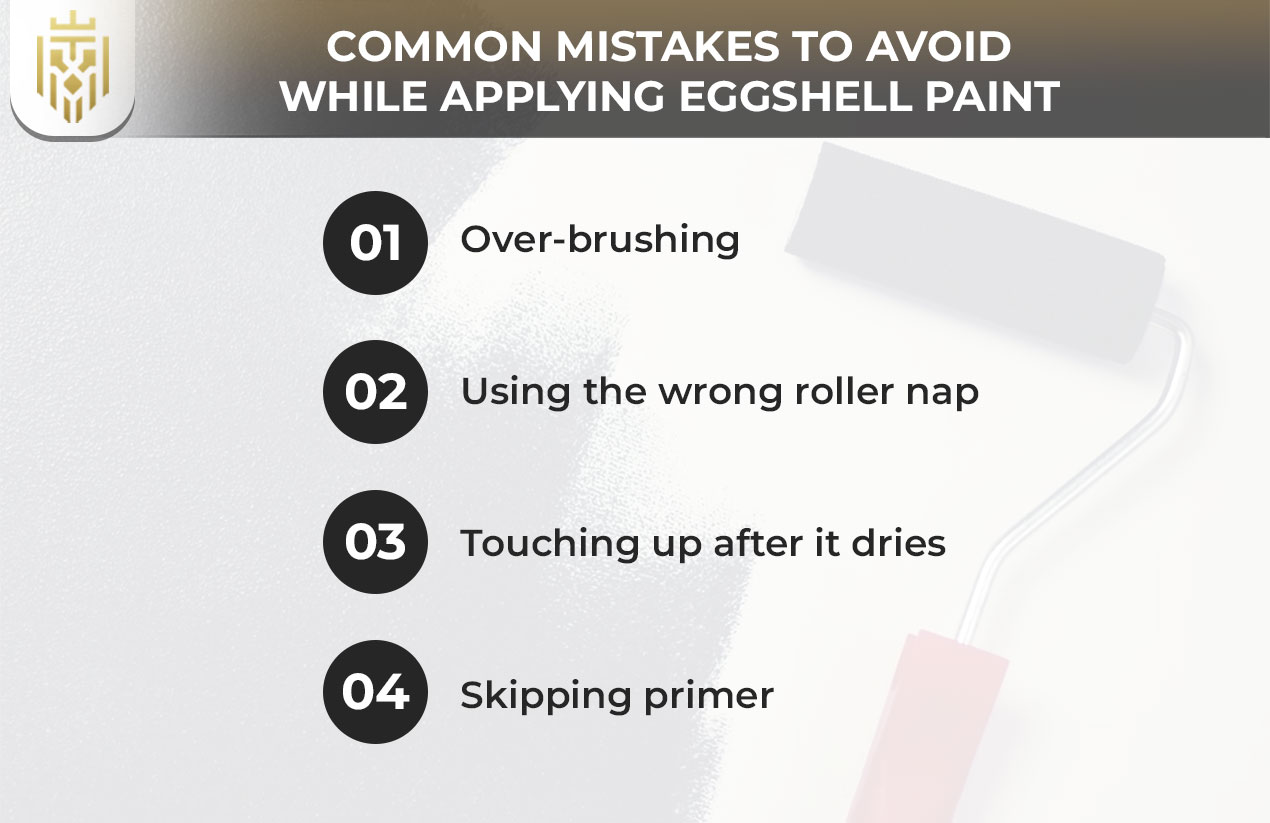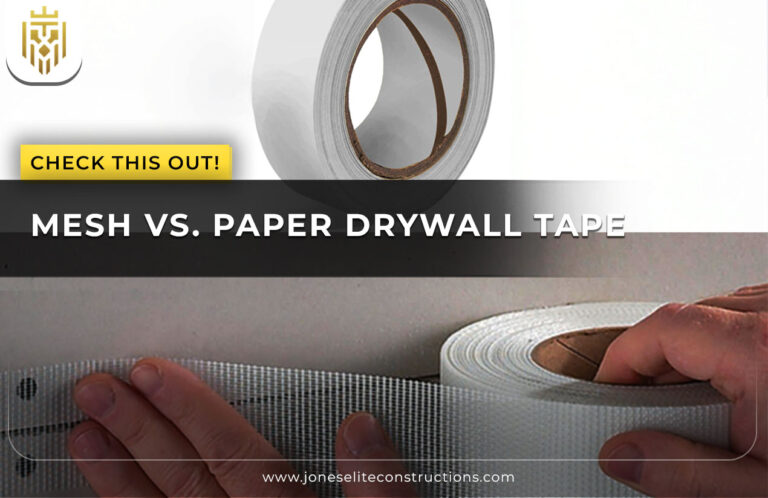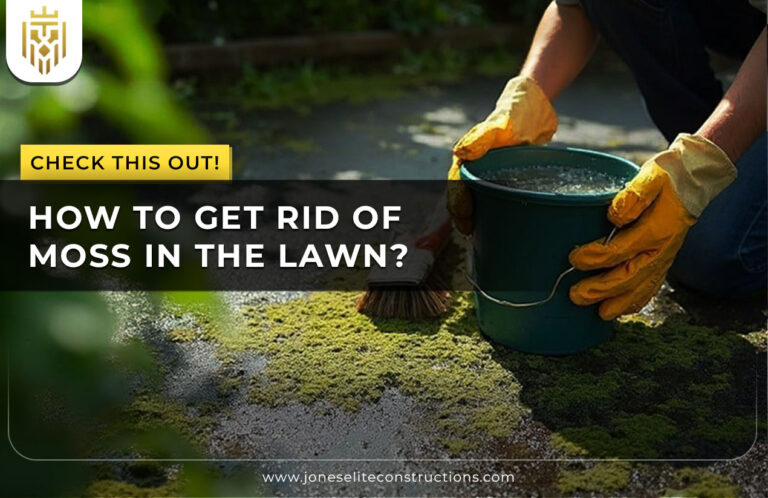What Is Eggshell Paint Finish?
The eggshell paint finish delivers a soft sheen falling between flat and satin, similar to the dull glow of a real eggshell. Making the correct compromise between shine and durability, it does its duty in inner spaces well, in terms of both beauty and practicality.
Where to Use Eggshell Paint Finish?
It works best in residential areas such as living areas, bedrooms, hallways, and dining rooms, which require a little sparkle and moderate protection from wear and tear. The subtle light will keep the walls polished without assertive reflections, suitable for slightly formal but casual decor.
Advantages of Eggshell Paint Finish

Eggshell paint offers a well-rounded combination of beauty, durability, and functionality that makes it a go-to option for many homeowners. Here’s why it stands out in interior painting:
Soft Sheen Appearance
This glow from the more-than-matte finish reflects ambient light along its way, without dominating the room. It brings out the wall color and gives the rooms a warm, inviting, natural feeling, yet it is slightly less glossy.
Hides Imperfections
Eggshell finishes hide imperfections in walls that might include slight dents, scratches, or undulations due to being of low sheen. Such a Paint finish tends to forgive any imperfections and works wonders on flat or empty walls, especially if they are aged or in high-traffic areas.
Easy Maintenance
These paints can be cleaned with a damp cloth along with mild detergent, thus making them highly suitable for homes with children and pets. Though it is not as resistant to scrubbing as satin, the paint wears well without affecting its appearance if cleaned occasionally.
Balanced Durability
Somewhere in between, its durability is greater than that of flat finishes and its shine less than that of glossier finishes. It is the right mix to resist wear and to retain the smooth matte look, which suits both casual and formal ambiances.
Versatility
Eggshell finish matches a wide array of interior styles—from traditional to contemporary—thanks to its appealing texture and sheen. It pairs beautifully with nearly every wall color and décor theme, enhancing rather than distracting.
Eggshell vs Other Paint Finishes
Comparing eggshell with other finishes helps you understand where it’s best applied and where alternatives might shine instead.
Satin versus Eggshell Paint Finish
Satin Paint Finish shines and lasts more than eggshell, so places with lots of moisture or heavy traffic—a bathroom or trim work, for instance—might be better off with satin. But, in main living areas where one would want a softer sheen and more help in covering imperfections, eggshell is the way to go.
Semi-Gloss vs. Eggshell Paint Finish
Semi-gloss is the shinier finish, being especially good to clean on those surfaces that see lots of contact—working doors, cabinetry, or kitchen walls, for instance. On the other hand, eggshell paints afford a more laid-back look, putting up as much fight against smudges and scuffs as is needed for most living spaces without calling too much attention to those marks.
Flat vs Eggshell Paint Finish
A flat finish absorbs light and hides imperfections, but it is the most prone to showing marks and stains. Eggshell, with a bit of shine and good toughness, is a bit more practical for day-to-day rooms.
How to Apply Eggshell Paint?
Eggshell paint requires a bit of technique to ensure a smooth, attractive finish. From prepping your surface to applying the final coat, following each step carefully will help you get professional-looking results.
Prep the Surface
Start by thoroughly cleaning the walls using a mild detergent with water to remove dust, dirt, or grease. Let the surface dry fully. If there were any holes, cracks, or uneven texture, patch them up with filler and sand them to smooth finishes. This preparatory stage allows for proper bonding of paint to the surface and an even-looking finish.
Add Prime (if needed)
Paint over new drywall, dark pigment, or stained areas except they are primarily accomplished with a primer. A primer presents a neutral base to the paint to enhance coverage. Use a primer suitable for the eggshell finish and apply one coat evenly over the whole surface. Observe the drying time as directed by the manufacturer before painting.
Apply Paint in Thin, Even Coats
Employ a good-condition brush or roller to angle long strokes beginning at the top of the walls and working down equally with thin coats of eggshell paint. Thin coats are better than thick and heavy ones, preventing drips and streaks or roller marks.
Allow to dry
After the first coat is applied, allow it to dry completely before deciding if a second coat is needed. Drying time can vary based on temperature and humidity but usually takes 2–4 hours. Avoid touching or spot-fixing areas while they’re drying, as this can leave visible marks on the finished surface.
Common Mistakes to Avoid while Applying Eggshell Paint

Even a great paint like eggshell can look bad if not applied properly. Here are common mistakes to watch out for:
Overbrushing
Reworking an area before it dries creates an uneven texture and sheen variation. Instead, apply the paint with smooth, confident strokes.
Using the wrong roller nap
A thick nap causes texture, while a nap that is too thin leaves uneven coverage. A three-eighths of an inch nap sits well with eggshell for interior walls.
Touching up after it dries
Touching areas when attempting to patch before the paint has started drying will create sheen inconsistencies. Always wait for full drying.
Skipping primer
Failing to prime in areas with stains, drastic color changes, or porous surfaces may lead to poor adhesion and uneven color. Primer gives a uniform premise for your topcoat.
FAQs
1) What is eggshell paint finish?
Eggshell paint finish is a less glossy to moderately glossy type of interior paint that offers a soft glow, a little more durability compared to flat finishes, and a wide application in living spaces.
2) What are the advantages of an eggshell paint finish?
It gives a light sheen to walls, hides wall imperfections, can be easily cleaned with just a wet cloth, can be sustained in busy areas, and can blend in with various décor styles.
3) What is the difference between satin and eggshell paint finishes?
Satin finish has greater luster and washability, making it suitable for wet or busy areas, while eggshell finish gives a much softer look and slightly compromises durability for dry and everyday living areas.
4) How to Apply Eggshell Paint?
Prep the surface, using a primer if necessary; apply by thin, even coats using the proper roller; allow a thorough drying time between coats; Common errors like over-brushing or foregoing primers should always be avoided.









